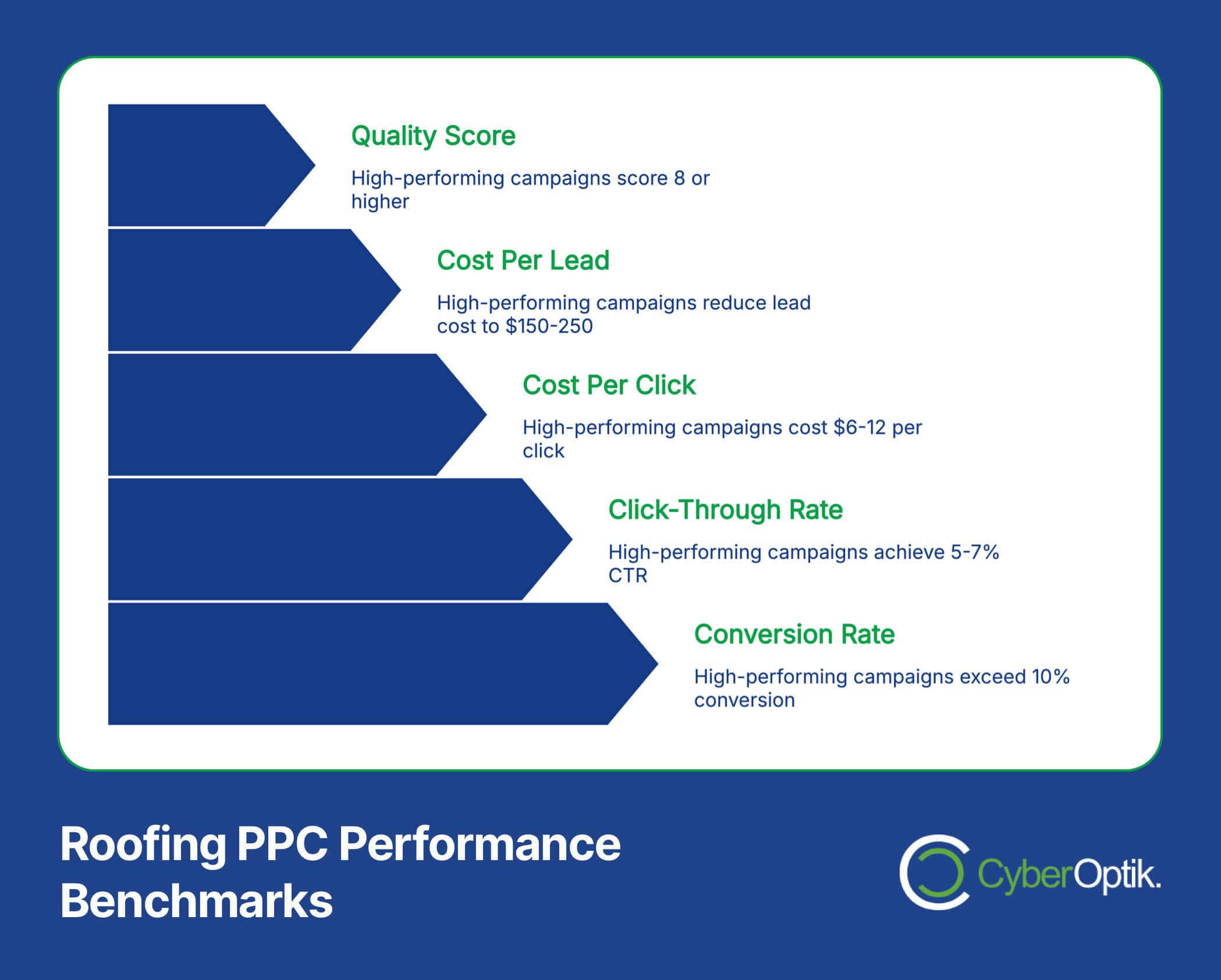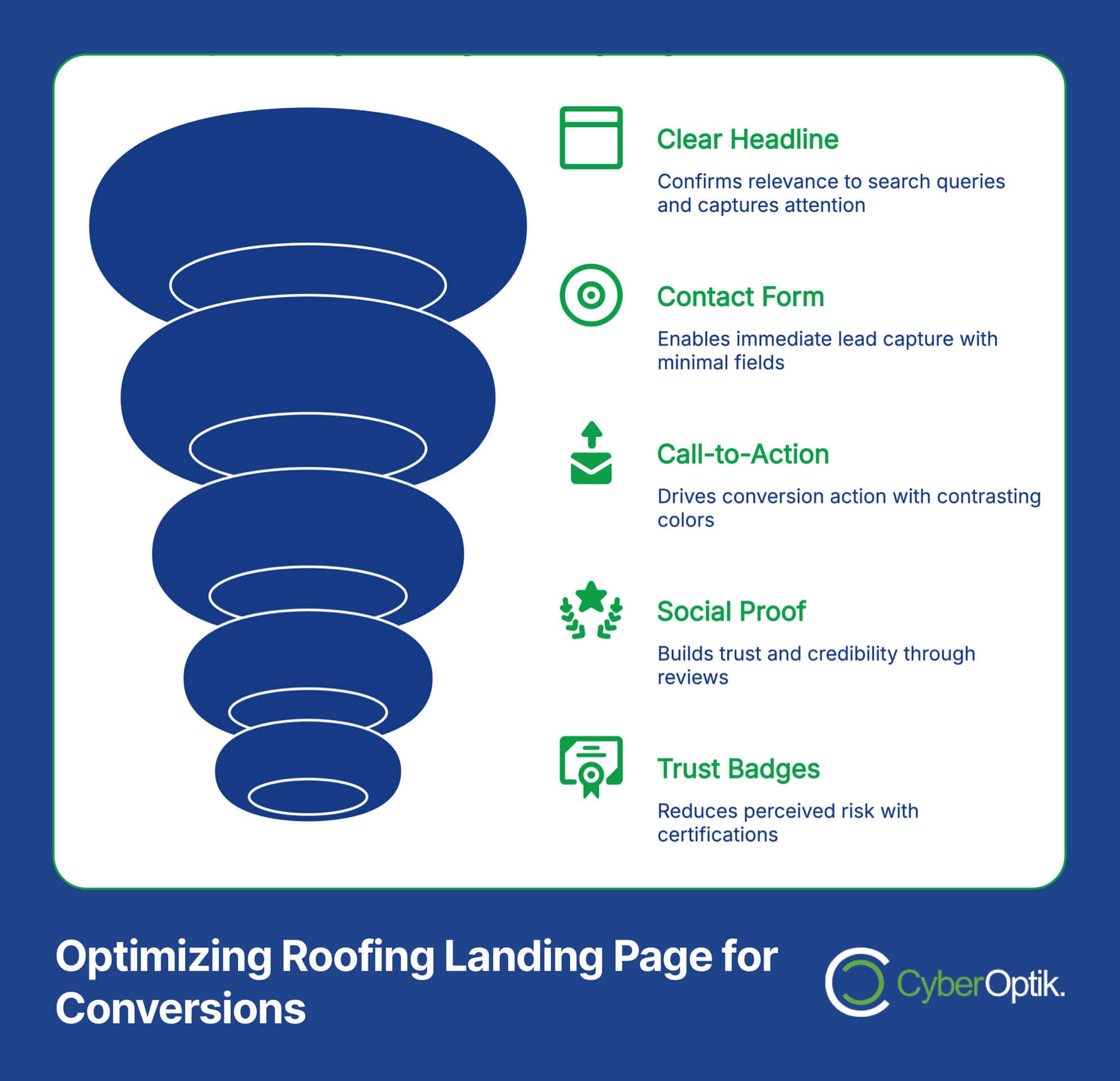Roofing companies face unique challenges in paid search advertising. The competition is fierce. Leads can be expensive. Without careful management, PPC campaigns quickly drain budgets with minimal returns.
We’ve seen this pattern repeatedly in the roofing industry. Most companies struggle with the same fundamental issues: poor keyword targeting, generic landing pages, and inadequate conversion tracking. These basic problems prevent otherwise solid businesses from achieving profitable campaigns.
In this comprehensive guide, we’ll explore proven strategies to maximize your roofing PPC results. You’ll learn industry benchmarks, effective keyword approaches, and advanced tactics to convert more clicks into qualified leads.
Understanding Roofing PPC Performance Benchmarks

Success in roofing PPC starts with knowing the numbers. Without clear benchmarks, you can’t effectively measure performance. Smart optimization requires data-driven targets.
Roofing PPC campaigns average a 2.35% conversion rate, but high-performing campaigns can achieve 10% or more. (Source: RoofingSites) This significant gap highlights the difference between average and optimized approaches.
What separates winning campaigns from underperforming ones? Several critical factors make the difference. These include targeted keyword selection, compelling ad copy, relevant landing pages, and proper tracking implementation.
Let’s examine the core performance metrics you should monitor in your roofing PPC campaigns:
| Performance Metric | Industry Average | High-Performing Benchmark | Impact on ROI |
|---|---|---|---|
| Conversion Rate | 2.35% | 7-10%+ | High |
| Click-Through Rate (CTR) | 2-3% | 5-7% | Medium |
| Cost Per Click (CPC) | $8-15 | $6-12 | High |
| Cost Per Lead (CPL) | $250-350 | $150-250 | Very High |
| Quality Score | 4-5/10 | 8+/10 | Medium |
The table above illustrates the significant opportunities available through campaign optimization. The difference between average and high-performing metrics directly impacts your bottom line.
One particularly valuable insight: PPC leads are twice as likely to convert compared to organic traffic. (Source: RoofingSites) This higher intent makes PPC an excellent channel for roofing companies seeking qualified leads.
While these benchmarks provide useful targets, your specific goals may vary based on geographic location, service mix, and competition level. Start by establishing your baseline metrics, then work toward incremental improvements.
Essential Keyword Strategy for Roofing Contractors
Keyword selection forms the foundation of successful roofing PPC. The right keywords connect you with homeowners actively seeking your services. Poor keyword choices waste budget on irrelevant traffic.
For roofing contractors, high-intent keywords deliver the best results. These search terms signal immediate need and purchase readiness. Examples include “emergency roof repair [city]” or “roof replacement quote near me.”
What makes keyword strategy so crucial in digital marketing for roofers? The answer lies in matching ad spend with customer intent. When these align, conversion rates and ROI typically improve dramatically.
Here’s a strategic breakdown of keyword categories for roofing PPC:
| Keyword Category | Example Keywords | Average CPC | Conversion Potential | Priority Level |
|---|---|---|---|---|
| Emergency Services | "emergency roof leak repair" "roof storm damage repair" | $12-18 | Very High | Top Priority |
| Replacement Services | "roof replacement cost" "new roof installation" | $10-15 | High | High Priority |
| Repair Services | "roof repair services" "fix leaking roof" | $8-14 | Medium-High | High Priority |
| Inspection Services | "roof inspection near me" "free roof inspection" | $6-12 | Medium | Medium Priority |
| Material-Specific | "metal roof installation" "asphalt shingle repair" | $9-14 | Medium-High | Medium Priority |
These keyword categories help you structure campaigns strategically. By organizing your roofing PPC account around these service groupings, you can create highly relevant ads and landing pages for each category.
Target high-intent keywords with location modifiers to maximize relevance. (Source: HawkSEM) For example, “roof repair Chicago” will typically convert better than simply “roof repair” because it matches local search intent.
Keyword research shouldn’t happen in isolation. Analyzing competitor keyword strategies provides valuable insights. Look for gaps in their targeting that you can exploit. Tools like SEMrush or SpyFu can reveal which keywords your competitors bid on.
Don’t overlook the power of branded search terms. For locally recognized roofing businesses, branded keywords can reduce CPC by 30-40%. (Source: WebRunner Media) This makes them an efficient addition to any roofing PPC strategy.
Finally, implement negative keywords aggressively. Exclude terms like “DIY,” “how to,” and “job” to prevent your ads from showing to people looking for employment or DIY solutions. This improves campaign efficiency by reducing irrelevant clicks.
Creating High-Converting Landing Pages for Roofing Leads

Even the best roofing PPC ads fail without effective landing pages. The landing page serves as the crucial bridge between ad click and lead conversion. It must instantly communicate value and drive action.
The first priority is page speed. A 1-second delay in page load speed can reduce conversions by 7%. (Source: WordStream) For roofing companies, this directly impacts lead volume and customer acquisition costs.
Mobile optimization is non-negotiable for roofing PPC landing pages. More than 60% of roofing searches occur on mobile devices. (Source: HawkSEM) Your landing pages must render perfectly on smartphones and feature easy tap-to-call functionality.
What elements should high-converting roofing landing pages include? The table below outlines the critical components and their impact on conversion rates:
| Landing Page Element | Function | Conversion Impact | Implementation Notes |
|---|---|---|---|
| Clear, Benefit-Driven Headline | Confirms relevance to search query | Very High | Should echo keywords from the ad |
| Prominent Contact Form | Enables immediate lead capture | Very High | Keep fields minimal (3-5 max) |
| Call-to-Action (CTA) Button | Drives conversion action | Very High | Use contrasting colors and action verbs |
| Social Proof Elements | Builds trust and credibility | High | Include ratings, reviews, testimonials |
| Service Area Map | Confirms geographic relevance | Medium | Highlight neighborhoods served |
| Trust Badges/Certifications | Reduces perceived risk | Medium-High | Include BBB, manufacturer certifications |
| Before/After Project Photos | Demonstrates quality work | Medium-High | Use high-quality, relevant images |
The most effective landing pages align precisely with ad messaging. This message match creates a seamless experience that increases conversion rates. For example, if your ad promotes “emergency roof repair,” your landing page should feature this exact service prominently.
Social proof plays a crucial role in landing page effectiveness. Include customer testimonials, review ratings, and case studies. This is particularly important for roofing companies, as 93% of consumers check reviews before making purchase decisions. (Source: WebFX)
Don’t overwhelm visitors with too many options. Instead of featuring every service on one page, create dedicated landing pages for different roofing services. This focused approach typically yields higher conversion rates by addressing specific customer needs.
Make contacting you simple and obvious. Include multiple contact options—phone, form, and chat—to accommodate different preferences. The primary contact method should stand out visually and appear above the fold.
Budget Planning and Bid Management
Effective budget planning makes the difference between profitable and wasteful roofing PPC campaigns. Without strategic budget allocation, even well-structured campaigns will struggle to deliver positive ROI.
Start with a clear formula for budget calculation. This structured approach ensures your spending aligns with business goals.
Here’s a strategic budget planning framework for roofing PPC:
| Budget Component | Calculation Method | Planning Considerations | Optimization Opportunities |
|---|---|---|---|
| Monthly Ad Spend | Target Leads ÷ (Expected Conv. Rate × Avg. CPC) | Based on business capacity and goals | Adjust based on performance data |
| Campaign Allocation | Percentage split between campaign types | Prioritize high-converting service categories | Shift budget to top performers monthly |
| Geographic Targeting | Budget weighted by service area priority | Focus on high-value zip codes/cities | Use location bid adjustments |
| Seasonal Adjustments | Percentage increase/decrease by season | Align with typical demand patterns | Capitalize on post-storm opportunities |
| Competitive Events | Reserved budget for competitive situations | Weather events, competitor activity | Rapidly deploy additional budget |
This framework provides a structured approach to budget allocation. By thinking strategically about each component, you can maximize the impact of every dollar spent on roofing PPC.
Properly optimized campaigns can achieve a $2 return for every $1 spent on PPC advertising. (Source: ComradeWeb) This positive ROI is achievable with diligent management and continuous optimization.
Bid management requires ongoing attention. Rather than setting bids and forgetting them, implement a regular review cycle. Adjust bids based on performance data, focusing budget on keywords with the best conversion rates and cost per acquisition (CPA).
Consider seasonality in your budget planning. Most roofing companies experience demand fluctuations throughout the year. Increase budgets during peak seasons and after severe weather events when search volume typically spikes.
For new campaigns, start with a testing budget to gather data before scaling up. This approach allows you to identify high-performing keywords and ads before committing larger amounts. Once you’ve identified winning combinations, gradually increase spending on proven performers.
Advanced Tracking and Measurement for Roofing PPC
Accurate tracking separates successful roofing PPC campaigns from failures. Without proper measurement, you can’t identify what’s working or calculate true ROI. Comprehensive tracking is essential for optimization.
The challenge for roofing companies is that many leads convert via phone calls rather than online forms. This makes call tracking particularly important. Implement a call tracking solution that integrates with your Google Ads account to attribute calls to specific campaigns, ad groups, and keywords.
Beyond basic conversion tracking, focus on validating offline conversions. This means tracking leads through your sales process to determine which PPC sources generate not just leads, but qualified opportunities and closed business.
Many contractors fail with Google Ads because they track only lead volume, not lead quality or eventual sales. This limited view leads to poor optimization decisions and wasted ad spend.
Here’s a comparison of different tracking methods for roofing PPC campaigns:
| Tracking Method | What It Measures | Implementation Complexity | Cost Range | Value for Roofers |
|---|---|---|---|---|
| Basic Conversion Tracking | Form submissions, button clicks | Low | Free | Minimal |
| Call Tracking | Phone call volume, source, duration | Medium | $50-200/month | High |
| CRM Integration | Lead quality, sales pipeline, close rates | Medium-High | $100-300/month | Very High |
| Revenue Attribution | Actual revenue from each lead source | High | $200-500/month | Very High |
| Customer Lifetime Value Tracking | Long-term value of PPC-acquired customers | Very High | Custom | Extremely High |
As the table shows, more advanced tracking methods deliver substantially higher value despite increased complexity and cost. The insights gained from robust tracking systems justify the investment through improved campaign performance.
Integrating CRM data reveals 70%+ lead quality thresholds as a key signal for scaling campaigns profitably. (Source: WebRunner Media) This deeper data allows you to optimize campaigns based on actual business outcomes rather than just click or lead metrics.
Track Customer Lifetime Value (CLV) against Cost Per Acquisition (CPA). (Source: Triton Commerce) This more sophisticated approach recognizes that some keywords might have higher acquisition costs but deliver customers with greater long-term value.
For multi-location roofing companies, implement location-specific tracking. This location-level data helps optimize budgets and targeting for different markets based on their unique performance characteristics.
Complementary Strategies to Enhance Roofing PPC Performance
PPC advertising doesn’t exist in isolation. The most successful roofing contractors combine PPC with complementary strategies. This integrated approach amplifies results across all marketing channels.
Local SEO plays a critical role in supporting PPC efforts. When potential customers see your business in both paid and organic results, it creates a perception of credibility and market leadership. Combine PPC with Google Business Profile optimization to maximize your visibility. (Source: Improve & Grow)
Remarketing provides another powerful way to enhance PPC performance. PPC ads increase brand awareness by 80%, even among users who don’t click immediately. (Source: ComradeWeb) Remarketing campaigns capture this awareness by re-engaging previous website visitors as they browse other sites.
What makes remarketing especially valuable for roofing companies? The high-consideration nature of roofing services means customers often research multiple companies before deciding. Remarketing keeps your brand top-of-mind during this research process.
Avoiding common AdWords budget waste requires a holistic approach that includes both PPC optimization and supporting strategies. This comprehensive perspective delivers better results than treating campaigns in isolation.
To maximize the effectiveness of your complementary strategies, consider:
- Review management – Actively solicit and respond to customer reviews, as 93% of consumers check reviews first
- Social proof integration – Feature testimonials and case studies in both ads and landing pages
- Content marketing – Create educational content that addresses common roofing questions and concerns
- Email nurturing – Develop automated email sequences for leads that aren’t ready to convert immediately
- Social media presence – Maintain active profiles showcasing completed projects and customer testimonials
PPC ads capture 45% of all clicks on search engine results pages (SERPs) for roofing-related queries. (Source: RoofingSites) While this is impressive, it means 55% of clicks go to organic results, highlighting the value of a combined paid and organic strategy.
When someone searches for roofing services, they’re typically experiencing an immediate need. Your marketing must address this urgency across all channels. Align messaging between PPC ads, organic listings, and social media to create a consistent impression of reliability and prompt service.
Taking Your Roofing PPC to the Next Level
Successful roofing PPC requires a systematic approach spanning keyword strategy, landing page optimization, budget management, and comprehensive tracking. Each component plays a vital role in creating campaigns that consistently generate qualified leads and positive ROI.
The data clearly shows the potential for roofing contractors who master PPC advertising. With conversion rates up to 10% achievable for optimized campaigns and a possible $2 return for every $1 spent, the opportunity is substantial.
For roofing companies looking to maximize their digital marketing results, we recommend:
- Establish baseline performance metrics for your current campaigns
- Implement comprehensive tracking, especially for phone calls
- Create service-specific landing pages optimized for conversion
- Focus on high-intent keywords with location modifiers
- Integrate PPC with complementary strategies like local SEO
The roofing industry’s competitive landscape demands excellence in PPC execution. By applying the best practices outlined in this guide, you’ll be well-positioned to outperform competitors and capture a larger share of high-quality leads in your market.
Ready to take your roofing PPC campaigns to the next level? We help roofing companies design and implement strategic PPC campaigns that deliver measurable results. Contact us to learn how we can help you generate more qualified leads and grow your roofing business.




